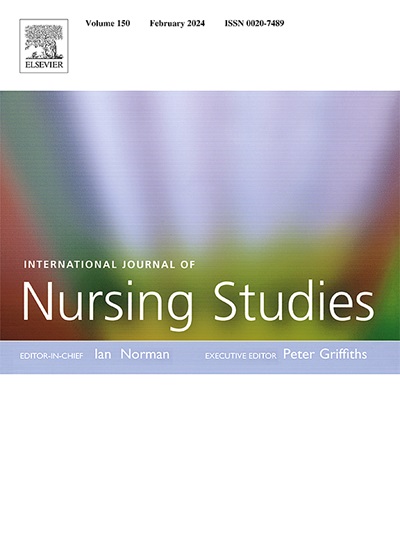Who gets the bed: Factors influencing the intensive care exit block: A qualitative study
IF 7.5
1区 医学
Q1 NURSING
引用次数: 0
Abstract
Background
Patient flow problems, including discharge delay and after-hours discharge, have been a consistently major issue, especially for intensive care units (ICUs). Evidence suggests that discharge delay and after-hours discharge are associated with increased ICU and hospital length of stay, leading to worsened patient outcomes and increased healthcare costs. They can also increase ICU readmission and post-ICU mortality. The factors influencing discharge processes are not well elucidated.
Objective
This study aimed to explore the barriers and facilitators to the ICU patient discharge processes in adult ICUs.
Methods
This qualitative exploratory multisite observational study was conducted in three regional adult ICUs in Queensland, Australia. We used staff interviews, fieldnotes, and document analysis as data collection techniques. Data analysis commenced with a deductive content analysis using the Structure, Process, and Outcomes framework. Following this, an inductive process was taken using the Theoretical Domains Framework.
Findings
We conducted 59 staff interviews and analysed the discharge documents across three sites. Four domains, including context and resources, beliefs about consequences, social/professional role and identity, and behaviour regulation, were strongly related to the factors that influenced the discharge processes. The findings revealed barriers to discharge, including finding the right bed, disconnected and ineffective information systems, ineffective communication and coordination within and across teams and departments, and uncertainty and inconsistency in discharge decision making. Facilitators included clarity on professional roles in ICU discharge, effective communication within the ICU team, and context specific strategies to support the discharge processes.
Conclusions
The findings provide an in-depth understanding of the barriers and facilitators to the ICU discharge processes. Multifaceted strategies should be considered to facilitate and manage ICU discharge safely and efficiently, including the use of clearer discharge criteria and guidelines, digital systems that aid communication and coordination, and early planning of ICU patient discharge.
病床归谁影响重症监护室出院区的因素:一项定性研究。
背景:病人流动问题,包括出院延迟和下班后出院,一直是一个主要问题,尤其是重症监护病房(ICU)。有证据表明,出院延迟和下班后出院与重症监护室和医院的住院时间延长有关,从而导致患者预后恶化和医疗费用增加。它们还会增加重症监护室的再入院率和重症监护室后的死亡率。影响出院流程的因素尚未得到很好的阐明:本研究旨在探讨成人 ICU 患者出院流程的障碍和促进因素:这项定性探索性多地点观察研究在澳大利亚昆士兰州的三个地区性成人重症监护病房进行。我们采用了员工访谈、现场记录和文件分析作为数据收集技术。数据分析首先使用结构、过程和结果框架进行演绎式内容分析。随后,我们使用理论领域框架进行了归纳分析:我们对三个地点的 59 名员工进行了访谈,并对出院文件进行了分析。四个领域,包括环境和资源、对后果的信念、社会/专业角色和身份以及行为调节,与影响出院过程的因素密切相关。调查结果揭示了出院的障碍,包括找不到合适的床位、信息系统脱节和无效、团队和部门内部及之间的沟通和协调不力,以及出院决策的不确定性和不一致性。促进因素包括明确专业人员在 ICU 出院中的角色、ICU 团队内部的有效沟通以及支持出院流程的具体策略:研究结果让我们深入了解了 ICU 出院流程的障碍和促进因素。为了安全有效地促进和管理 ICU 出院,应考虑采取多方面的策略,包括使用更明确的出院标准和指南、有助于沟通和协调的数字系统以及 ICU 患者出院的早期规划。
本文章由计算机程序翻译,如有差异,请以英文原文为准。
求助全文
约1分钟内获得全文
求助全文
来源期刊
CiteScore
15.00
自引率
2.50%
发文量
181
审稿时长
21 days
期刊介绍:
The International Journal of Nursing Studies (IJNS) is a highly respected journal that has been publishing original peer-reviewed articles since 1963. It provides a forum for original research and scholarship about health care delivery, organisation, management, workforce, policy, and research methods relevant to nursing, midwifery, and other health related professions. The journal aims to support evidence informed policy and practice by publishing research, systematic and other scholarly reviews, critical discussion, and commentary of the highest standard. The IJNS is indexed in major databases including PubMed, Medline, Thomson Reuters - Science Citation Index, Scopus, Thomson Reuters - Social Science Citation Index, CINAHL, and the BNI (British Nursing Index).

 求助内容:
求助内容: 应助结果提醒方式:
应助结果提醒方式:


